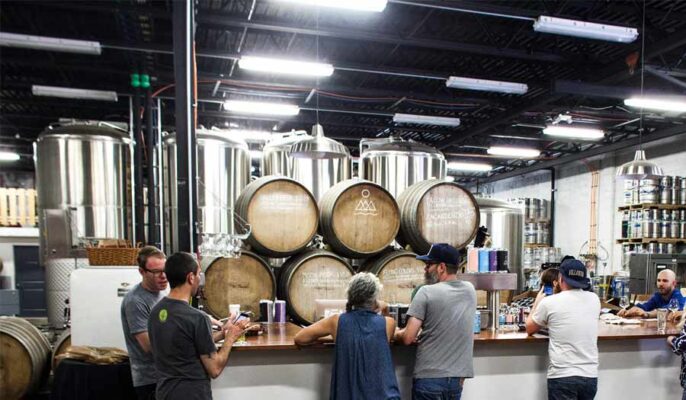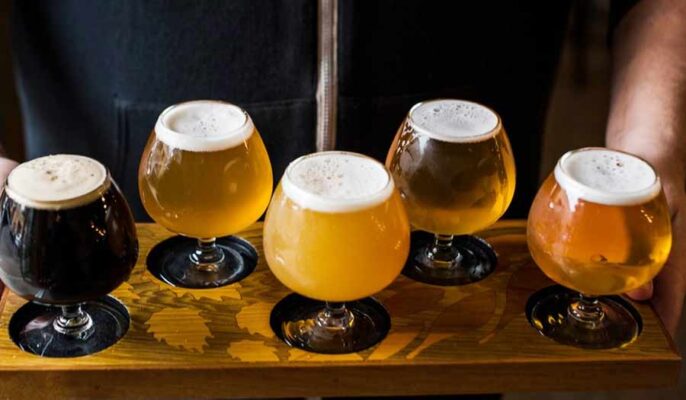Beer is made from four basic ingredients: barley (or other grains), water, hops, and yeast. The basic idea is to extract sugar from the grain, which is then converted by yeast into alcohol and carbon dioxide to create beer. Brewing is a combination of science and art. Brewers use a basic scientific process and get creative by varying the combination of grains, hops, and yeast to produce a wide range of beer styles.
クラフトビールとは何か?
Craft beer is usually brewed by independent breweries using traditional ingredients such as malt, hops, water, and yeast, and is often produced in smaller quantities. Being craft beer, the process of making craft beer tends to have more attention to detail than mass-produced beers, resulting in unique flavors and higher-quality products.
Characteristics of craft beer:
- No more than 6 million barrels of beer are produced annually
- Non-craft breweries can control less than 25% of the brewery’s shares
- The beer itself is at least one of the brewery’s main products or accounts for more than 50% of sales
- No supplements are used in the making of the product
- 人工添加物や香料は使用していません

Ingredients in craft beer
- Malt: All beers start with malt. Traditionally, malt is barley, but oats and rice can also be used. The grains are roasted and dried, then ground to release the enzymes needed to brew beer. The malt will determine the color of the finished beer. Light roasting gives the beer a light color. Dark roasting also darkens the beer.
- Hops: Hops play an important role in beer brewing. They give beer the citrusy, earthy flavor we all know and love. There are many different types of hops and each one provides the beer with a different flavor. Many brewers will blend multiple hops to create more complex flavors. That’s how Tropigamma gets its juicy, fruity flavor. Or the reason Neck Oil gets a more rustic flavor.
- Water: You can’t make beer without water! Beer is 90-95% water. Water affects the flavor of the finished beer. Hard water gives soft water a different flavor because of the minerals dissolved in the water. That’s why beer tastes different all over the world, even if they use the same malt and hops!
- Yeast: Yeast is the last ingredient needed to brew beer. Yeast is added to ferment the mixture. It breaks down the sugars and carbohydrates and converts them into alcohol for you to enjoy at the bar.
How to brew craft beer?
粉砕とマッシュ
Milling is the first step in the beer brewing process. The milling process involves crushing grains such as malt, barley, wheat, rye, oats, or corn into small pieces for brewing beer. The seeds go through a malting process. The goal is for the seeds to begin to germinate as if they were going to grow. Germination activates the enzyme amylase, which is necessary to produce fermentable sugars when yeast is added to the process.
However, germination must be stopped at the proper time. Grain harvested from the field usually contains 10% to 12% moisture, and soaking (water immersion) raises its moisture content to about 45%, causing it to germinate. If left untreated, the grain will root and germinate. When germination stops, the grain is dried by drying, and the moisture content is reduced to 3 to 5 percent. The final stage is the roasting of the grain. The maltsters (specialists in making a variety of malted grains) decide on the type of roasting.
マッシュ
Beer brewing begins with a single step. During mash, malt is mixed with hot water. As the name implies, mash is the process of mixing dry barley, wheat, and/or other grains into water to form a glutinous substance that resembles a thin porridge. This is the malt syrup.
Since the malt is partially crushed before steeping, the hot water can get into each kernel, exposing the natural starches in it. This is exactly what brewers want, as these starches are converted into sugars by the grain’s enzymes. These sugars are then used as a food source by the yeast to produce alcohol and carbon dioxide. From the malt syrup, great things begin.
ろ過
Leaving the solids behind allows the liquid to continue to turn into beer. Adding more water to the top of the grain bed allows the water to seep through – taking the sweet, sugary liquid with it. This stage is either done in the original wort bucket or in a separate container called a filter tank, but both require a perforated base to allow the liquid to flow out.
At first, the outflow of wort (now called wort) becomes cloudy from unwanted hulls and other particles. Brewers typically reintroduce this first outflow of wort to the top of the grain bed for further filtration.
Filtration helps clarify the wort and removes any unwanted proteins and other particles that may affect the flavor and clarity of the beer.
沸騰
The wort is transferred to another large vessel to be heated. The wort will boil vigorously in this large vessel for over an hour – depending on the style of beer. This prolonged heating will stop the enzyme activity at the wort stage, fix the amount of sugar available to the yeast, and sanitize the wort at the same time. From this stage on, anything that touches the beer must be sterile. Brewers are notorious cleaners.
The boiling stage is also usually where hops are added. We often add hops (and sometimes even wort) to the filtration stage as well to add flavor, but almost every beer you drink will have hops added during the boil. This is because heat changes the internal structure of hops, releasing alpha and beta acids, and carefully timed additions make a difference. The earlier the hops are added the more bitter the flavor. Later additions are more for aroma and flavor.
発酵
The wort is transferred to the 発酵容器 and the yeast is added. Ale yeast floats to the top of the wort, while lager yeast usually collects at the bottom. This stage is primary fermentation – the conversion of sugar into alcohol and carbon dioxide to produce an ale or lager depending on the type of yeast used.
Once the yeast is placed at the proper temperature, the beer’s temperature is usually maintained at 60 to 68 degrees Fahrenheit (for ales) and 50 degrees Fahrenheit (for lagers). The process of the yeast converting sugar to alcohol generates heat and is closely monitored by the brewer. The higher the temperature used by the ale yeast, the more esters or aromatic organic compounds are produced.
Fermentation is the process of converting sugar into alcohol and carbon dioxide. It is the most important part of the brewing process and the key to making great-tasting craft beer. During fermentation, the yeast consumes the sugars in the wort, produces alcohol, and brews the beer.
Storing Beer
During the fermentation of malt beers and lagers, the beer matures and smoothes out and the fermentation by-products are reduced. Dry hops can be added at this stage to increase aroma, and other methods such as barrel aging can add further complexity. The beer is refrigerated for up to 30 days (known as “storage beer”), and one of the main differences between storage beers and malt beers is that they are cleaner and have more distinctive flavors.

Packaging and carbonation
Once the beer has been fermented, it must be kegged or bottled and naturally or forcibly carbonated. Forced carbonation involves adding carbon dioxide to the container under high pressure to force it to be absorbed by the beer. Most breweries use forced carbonation because it is a faster process that results in a clearer beer. Once the beer is packaged and aerated, it is ready to be enjoyed. Packaging and aerating are the final steps of the brewing process, and they play an important role in the quality and shelf life of the beer.
よくあるご質問
What is the shelf life of craft beer?
In general, craft beer should be consumed within three to six months of the production date. For the best flavor, it is best to store craft beer at the proper temperature and out of direct sunlight.
クラフトビールと普通のビールの違いは?
The main difference between craft beer and regular beer is the brewing process and the scale of production. Craft brewers prioritize quality ingredients, hands-on brewing techniques, and experimentation, resulting in beers that are often tastier and more complex than mass-produced beers.
Do microbreweries brew beer or craft beer?
Microbreweries are often synonymous with craft breweries, as both terms refer to small, independent craft breweries. However, some microbreweries may not meet the strict standards set by craft beer industry organizations such as the American Brewers Association.
クラフトビールと市販ビールの違いは?
Craft beer and commercial beer differ in all aspects of brewing methods, ingredients, and target audiences. Craft beer focuses on quality, innovation, and community involvement, while commercial beer focuses on mass production, wide distribution, and annual sales revenue.




